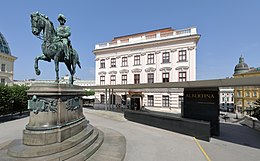User:OberMegaTrans/ss2023/Albertina(Vienna)
| This article is currently the subject of an educational assignment. |
Albertina (Vienna)
[edit]
 Albertina with Archduke Albrecht Monument | |
 | |
| Established | 1805[citation needed] |
|---|---|
| Location | Albertinaplatz 1, Vienna, Austria |
| Coordinates | 48°12′15″N 16°22′07″E / 48.20417°N 16.36861°E |
| Type | Art museum |
| Visitors | 360,073 (2020) |
| Founder | Duke Albert Casimir |
| Director | Dr. Klaus Albrecht Schröder |
| Public transit access | U1, U2, U4 (Karlsplatz) |
| Nearest parking | Operngarage |
| Website | www |
The Museum
[edit]The museum is placed in the Palais Archduke Albrecht of the Hofburg, a historical residence of the House of Habsburg. The name Albertina refers to Albert Casimir, Duke of Teschen, son-in-law of Archduchess Maria Theresa, wife of Emperor Francis I. He founded the art collection in 1776 in Pressburg, where he had ruled over the Kingdom of Hungary as a representative of Maria Theresa. Later on, Albert also officiated as a representative of the Austrian monarch in the Austrian Netherlands, from which, in 1792, he brought most of the art collection to the Albertina in Vienna. The encyclopedic and universal collection contains about one million drawings and graphics from the Renaissance up to recent artworks.
Since 2007, the museum exhibits Batliner’s private collection on a permanent loan, and therefore uses most of the museum space for the exhibition of modern and contemporary art called “Monet to Picasso: The Baitliner Collection”. All collections of the Albertina are stored in full-automatic high-bay storage.
The Collection
[edit]Albert’s collection is considered one of the most significant ones in the world. In a timespan of over 50 years, he collected around 14.000 drawings and 200.000 graphics through networking in the European trading market and participating in many private auctions. Many famous and art history-relevant works such as Michelangelo’s male figure drawings, Albrecht Dürer’s Young Hare, and Peter Paul Rubens’ child portraits are part of Albertina’s permanent collection.
One of the significant reasons for Albert’s interest in collecting artwork was his art-loving wife, Maria Christina, who was also able to support Albert financially. Their collection contained artworks from the 15th up to ones from the early 19th century. From the beginning, Albert ordered his collection systematically after important criteria, schools, and art landscapes. German and Austrian paintings and graphics are predominant in the collection, followed by Dutch, Italian, and French artworks.
In the last two decades of Albert’s life, he purchased more and more contemporary art (“Maîtres modernes”), which now make up about one-third of the whole collection. All drawings from Albert’s collection are signed by the duke’s personally designed stamp showing his monogram “AS” which stands for “German: Albert von Sachsen” (Albert of Saxony). Besides history and genre paintings, Albert's favorite artworks were landscape paintings. He preferred paintings with clear brushwork and color, and also artwork in the wash technique.
In 1816, Duke Albert asked for a fideicommissum, which is why the collection was handed over to his adoptive son and heir Archduke Charles, in 1822 and after, was taken care of by Charles’ sons Archduke Albrecht and Friedrich. In 1919, after the Habsburg fideicommissum and the end of the monarchy, the art collection was, according to the Habsburg Law, declared Austrian nationalized property. The collection has been preserved in its original condition up until now. The over 25.00 books of the library and all interior were lastly private property of Archduke Friedrich and were seized and sold to the public in 1919. In recent years, the Albertina Museum decided to buy some of the original interior back, to reconstruct the rooms of the palace to how they looked in the time of Habsburg.
